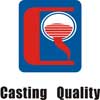ASTM A105 is a popular carbon steel which widely used in flanges products.
- Principal Features: A 105 is an ASTM specification dealing with forged carbon steel piping components. The steel alloy involved is a low carbon, manganese and silicon containing steel similar to AISI 1330, but with lower manganese content.
- Applications: This ASTM specification covers carbon steel forgings for piping applications such as flanges and fittings
- Machinability: Machinability is good as for any of the low alloy steels.
- Forming: This specification covers forming by forging only.
- Welding: The steel covered by this specification is weldable. Weld procedures used must be qualified with Section IX of the ASME Boiler and Pressure Vessel Code.
- Heat Treatment: Heat treatment is not required except for flanges or piping components as called out in ASTM A 105/A section 5.1. When heat treatment is required it consists of normalizing at 1550 to 1700 F and air cooled. Quenching direct from the forging heating shall be followed by a temper at 1100 F and air cool.
- Forging: This is a forging alloy that would be forged at temperatures in the range of 2200 to 1700 F followed by quenching and tempering or normalizing.
- Hot Working: See “Forging”.
- Cold Working: This specification does not cover cold working other than machining.
- Annealing: Annealing may be done by first allowing the forged parts to cool to below 1000 F and then reheat to between 1550 and 1700 F followed by slow furnace cooling.
- Aging: Not applicable.
- Tempering: Tempering is done at 1100 F followed by air cooling.
- Hardening: See “Heat treatment” and ” Tempering”.
- Other comments: Physical and mechanical properties are similar to those for AISI 1330 steel. Consult ASTM A105 for requirements as to strength and hardness.
- Chemical Requirements:
ElementComposition, %Carbon 0.35 maxManganese 0.60–1.05
Phosphorus 0.035 max
Sulfur 0.040 max
Silicon 0.10–0.35
Copper 0.40 maxA
Nickel 0.40 maxA
Chromium 0.30 maxA,B
Molybdenum 0.12 maxA,B
Vanadium 0.08 max
0.35 max0.60–1.05
0.035 max
0.040 max
0.10–0.35
0.40 maxA
0.40 maxA
0.30 maxA,B
0.12 maxA,B
0.08 max
- Mechanical Requirements:
